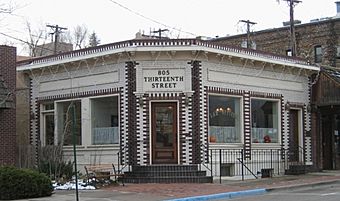Quaintance Block facts for kids
Quick facts for kids |
|
|
Quaintance Block
|
|
 |
|
| Location | 805 13th Street, Golden, CO |
|---|---|
| Built | 1911 |
| Built by | James H. Gow |
| Architect | James H. Gow |
| Architectural style | Early Commercial |
| NRHP reference No. | 94000261 |
| Added to NRHP | March 25, 1994 |
The Quaintance Block is a special building in downtown Golden, Colorado. It was the first shop in this historic area to be added to the National Register of Historic Places. This means it's a very important building for its history and design! Built in 1911, it has a unique look, mixing old-fashioned Victorian styles with newer, modern ideas. It's also famous for its shiny, experimental bricks. Many local people still remember it as the Spudnut Shop. It was officially listed on the National Register in 1994. The building includes the original 1911 brick structure, a newer basement, and an addition at the back.
History of the Quaintance Block
The Quaintance Block was first built in 1911. It stood on the corner of 13th Street and Washington Avenue in Golden. Charles F. Quaintance, whose family were early settlers, built it. He wanted a new place for his businesses. The building had three storefronts. One was for his photo shop, another for his realty company, and the third for his brother Arthur's law office.
Charles Quaintance was a very smart businessman. He placed his building across from Golden's tramway stations. This helped him attract people visiting his Castle Rock Resort. Tourists would get their pictures taken with burros (small donkeys). These burros would then take them up the mountain. While they were gone, Quaintance would develop their photos. The pictures would be ready when the tourists came back!
After the resort became less popular, Quaintance focused on other things. In 1923, he moved the entire building 65 feet to the west. This made space for the first gas station in downtown Golden. The building then faced a courtyard. Charles Quaintance passed away in 1940. His father, Brough, took over the business until he died in 1946. After that, the investment company closed.
The building was later sold to Ernie Waters. He turned it into the Golden Furniture Store. Later, Leonard and Pat Dunn opened the Spudnut Shop there in 1953. This shop became very popular with people in Golden. It was part of a national chain that sold delicious donuts made from potato flour. These were called "spud"nuts. Customers bought them at the shop, and delivery boys also carried baskets of Spudnuts around town. The shop closed in 1984.
After some time, the building was carefully restored in 1990. Conrad and Ingrid Gardner led this project. They now own the building, which houses their law office and other businesses. The Quaintance Block was named a Golden and Colorado landmark in 1993. It was added to the National Register of Historic Places in 1994. It's rare for a building that has been moved to get such a high honor!
What Makes the Architecture Unique?
The Quaintance Block has a very special design. It has puzzled and fascinated people who study old buildings for many years. The building is made of unique glazed bricks. These bricks came from a company in Golden that operated in the 1910s. The Quaintance Block is one of only three known buildings still standing that use these special bricks. The bricks were known for being beautiful and not cracking easily.
The overall design of the shop is a mix of old and new. It has a fancy metal trim at the top that looks back to older styles, even ancient Greek designs. But its mostly white walls and geometric shapes look forward to more modern art styles. The special brickwork on the corners adds to its unusual look. The Quaintance Block was designed and built by James H. Gow. He grew up in Golden and studied at Jarvis Hall college.

